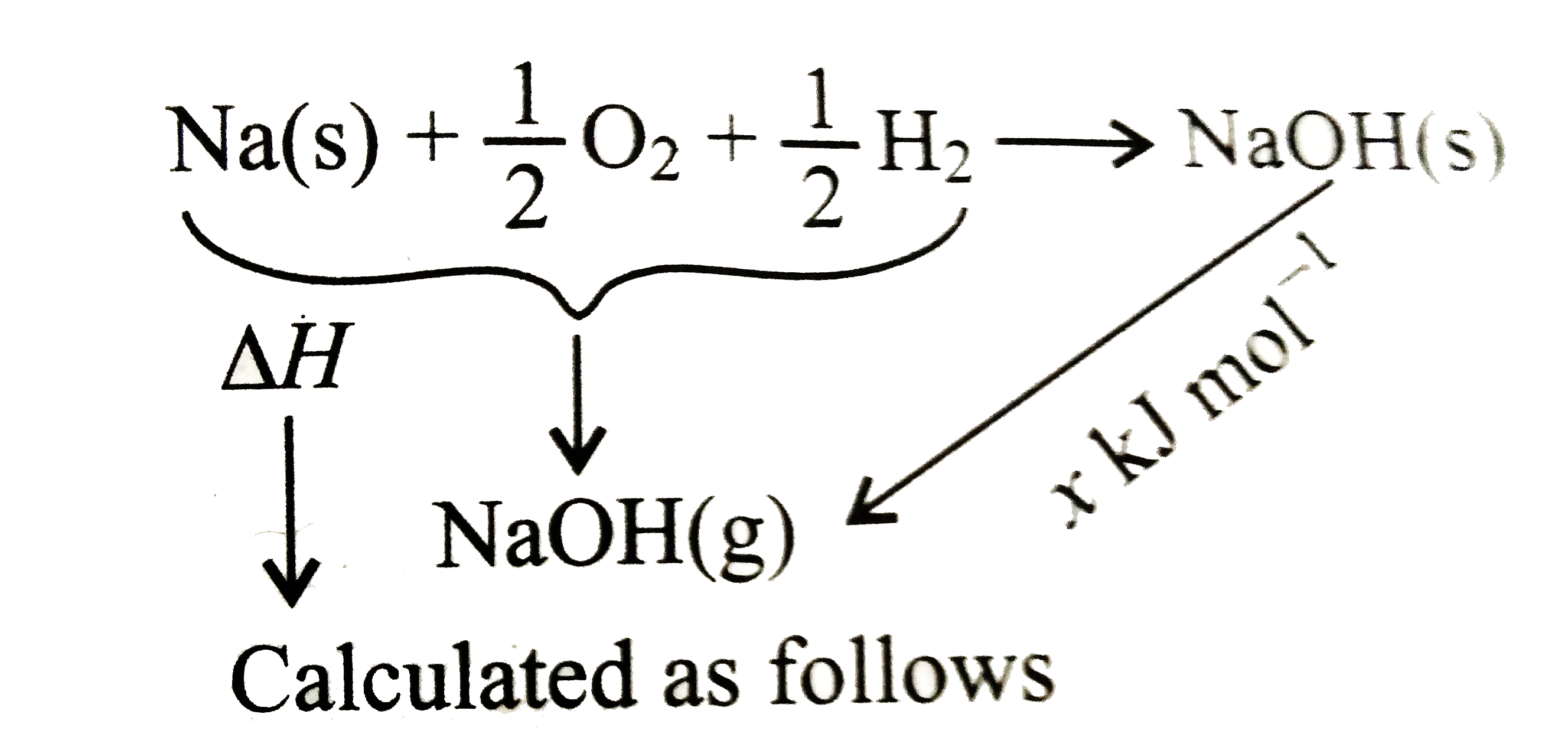Find of the process
Given:

Calculated as follows
Now,
Topper's Solved these Questions
- THERMODYNAMICSBOOK - CENGAGE CHEMISTRYCHAPTER - THERMODYNAMICSEXERCISE - Ex 6.4
16 Videos
- THERMODYNAMICSBOOK - CENGAGE CHEMISTRYCHAPTER - THERMODYNAMICSEXERCISE - Ex 6.5
30 Videos
- THERMODYNAMICSBOOK - CENGAGE CHEMISTRYCHAPTER - THERMODYNAMICSEXERCISE - Ex 6.2
27 Videos
- STOICHIOMETRYBOOK - CENGAGE CHEMISTRYCHAPTER - STOICHIOMETRYEXERCISE - Archives Subjective
33 Videos
Similar Questions
Calculate Δh for the eaction
BaCO3(s)+2HCI(aq)→BaCI2(aq)+CO2(g)+H2O(l)
ΔfHΘ(BaCO3)=−290.8kcalmol−1,ΔfHΘ(H⊕)=0
ΔfHΘ(Ba++)=−128.67kcalmol−1,
ΔfHΘ(CO2)=−94.05kcalmol−1,
ΔfHΘ(H2O)=−68.32kcalmol−1
View SolutionCalculate enthalpy change for the process CCl4(g)→C(g)+4Cl(g) and calculate Bond enthalpy of C−Cl bond in CCl4
Given: ΔvapHθ=30.5kJmol−1,ΔfHθ(CCl4)=−135.5kJmol−1,ΔaHθ(C)=715kJmol−1andΔaHθ(Cl2)=242kJmol−1
View Solution
Knowledge Check
Given ΔiHΘ(HCN)=45.2kJmol−1 and ΔiHΘ(CH3COOH)=2.1kJmol−1. Which one of the following facts is true?
ApKa(HCN)=pKa(CH3COOH)BpKa(HCN)>pKa(CH3COOH)CpKa(HCN)<pKa(CH3COOH)DpKa(HCN)=(45.17/2.07)pKa(CH3COOH)Calculate the EA of O atom to O2− ion from the following data:
i. ΔfHɵ[MgO(s)]=−600kJmol−1
ii. ΔuHɵ[MgO(s)]=−3860kJmol−1
iii. IE1+IE2 of Mg(g)=2170kJmol−1
iv. ΔdissHɵ of Mg(s)=+494kJmol−1
v. ΔsubHɵ of Mg(s)=+150kJmol−1A+693kJmol−1B−693kJmol−1C+69.3kJmol−1D−69.3kJmol−1The value of log10K for a reaction A⇔B is (Given: ΔfHΘ298K=−54.07kJmol−1,
ΔrSΘ298K=10JK=1mol−1, and R=8.314JK−1mol−1A5B10C95D100
Consider the reaction:
4NH3(g)+5O2(g)→4NO(g)+6H2O(l)ΔGΘ=−1010.5kJ
Calculate ΔfGΘ[NO(g)]ifΔfGΘ(NH3)=−16.6kJmol−1 and ΔfGΘ[H2O(l)]=−237.2kJmol−1.
View SolutionCalculate the resonance enegry of toulene (use Kekule structure form the following data
C7H8(l)+9O2(g)→7CO2(g)+4H2O(l)+ΔH,ΔHΘ=−3910kJmol−1
C7H8(l)→C7H8(g),ΔHΘ=38.1kJmol−1
ΔfHΘ(water)=−285.8kJmol−1
ΔfHΘ[CO2(g)]=−393.5kJmol−1
Heat of atomisaiton of H2(g)=436.0kJmol−1
Heat of sulimation of C(g)=715.0kJmol−1
Bond energies of C−H,C−C, and C=C are 413.0,345.6, and 610.0kJmol−1.
View SolutionCalculate the resonance energy of gaseous benzene form the following data.
BE(C−H)=416.3kJmol−1
BE(C−C)=331.4kJmol−1
BE(C=C)=591.1kJmol−1
ΔsubHΘ(C,graphite)=718.4kJmol−1
ΔdissHΘ(H2,g)=435.9kJmol−1
ΔfHΘ(benzene,g)=82.9kJmol−1
View SolutionCalculate the lattice energy of the reaction
Li⊕(g)+CIΘ(g)→LiCI(s)
from the following data:
ΔsubHΘ(Li)=160.67kJmol−1,12D(CI2)=122.17kJmol−1IP(Li)=520.07kJmol−1,EA(CI)=−365.26kJmol−1 and ΔfHΘ(LiCI)=−401.66kJmol−1
View SolutionIf ΔfH∘_(C3H8(g))=−85kJmoll−1,
ΔfH∘_(C3H8(g))=−104kJmol−1,
ΔH for C(s)→C(g) is 718kJmol−1 and heat of formation of H− atom is 218kJmol−1, then :
View Solution
